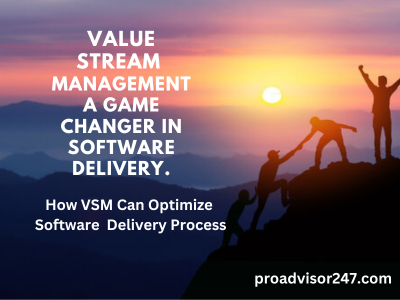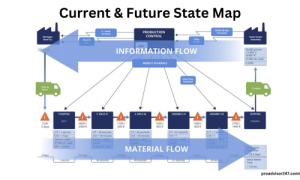
VSM (Value Stream Management) is a systematic approach to optimizing and streamlining the end-to-end software delivery process. It seeks to improve cooperation, visibility, and efficiency by evaluating, visualizing, and optimizing the value flow from conception to consumer delivery. Organizations can use VSM to identify bottlenecks, decrease waste, and align development activities with business goals.
VSM develops a culture of continuous improvement by empowering teams to evaluate, monitor, and continually improve their workflows, resulting in faster delivery cycles, increased customer satisfaction, and, ultimately, superior business outcomes.
Also, learn more about What Is Intelligent Automation & An Executive’s Guide.
VSM For Software Delivery
• VSM gives leadership the ability to optimize their software delivery process
• It works on Lean techniques and processes which helps teams understand, prioritize, and adjust to their ways of working in order to accelerate their software delivery.
• VSM is a great means for identifying bottlenecks and locating improvement opportunities within the software development life cycle.
• It improves cross-team communications by reducing the levels of confusion, happening when the task passes through different development stages.
Values In VSM
In a VSM, values are related to the
• Flow of information
• Flow of materials
• Flow of time
These three types of flows are required for all organizations and businesses to deliver a product/service to a consumer.
Software Development Challenges
• The biggest challenge in developing software in a value stream approach is staying focused on customer value.
• In any project, the cost and schedule are the parameters to maximize. However, for a value stream, the goal is maximizing value over time. That’s a completely different equation.
• Involving experienced people from the business side and product side in conducting value stream mapping since the mapping process could be vastly cross-functional and complex.
• Fear and uncertainty are common symptoms when value stream mapping is conducted, and so the process of identifying waste can be intense.
To Know More About What Is Azure IoT And It’s Services, Click HERE.
Areas Where VSM Can Help To Optimize
- Incomplete/Partial Work Done
- Extra Or Not Need Feature
- Extra Processing Or Extra Documentation
- Task Switching
- Waiting/Delays
- Hand Off
- Defect
VSM Tools And Software
Below are a few of the tools and software used for VSM:
•Capstera
• Plutora
• EDraw Max
• Lucid Chart
• Copado
• Jira VSM
• LinearB
Steps To Improve Flow In Software Development Through VSM
Step 1: Identify Processes – A list of potential processes should be identified.
Step 2: Team Creation – VSM team should include representatives from every cross-functional team
involved in the process.
Step 3: Map Steps – Each of the steps within the selected process should be mapped.
Step 4: Data Collection – When mapping the process’s activities, data should be collected for specific
people or roles involved in each step, time taken to finish and wait time for each step, and how frequently a
“finished” task is re-opened because further work is required.
Step 5: Create a Timeline – Once the software has been released, it’s time to turn a list of steps and process
data into a visual value stream map.
Step 6: Analyzing the Map – Analyzing the VSM is important to identify the problem source(s). Then it will
help to determine the problems to reduce waste in the SDLC.
How Organizations Can Overcome Challenges Through Efficient VSM
BACKGROUND
• Organization is a leading firm in IT services. However, the company faces several challenges in delivering IT services such as database provisioning.
• Due to process inefficiency, it creates a high number of project escalations which lead to additional costs
to the company.
• So it decided to implement VSM to map the processes as it is and applies a systematic way to analyze the processes to identify bottlenecks and areas of improvement.
PROBLEM DEFINITION
• One of the bottlenecks in the delivery of IT services is the database support and service process in the Database
department.
• As constantly changing business demands, the current database server provisioning process is no longer suitable to meet the level of requirements.
• It becomes necessary to review the current processes and evaluate them against new demands and forecasting.

Conclusion
By applying VSM in any organization it was observed that an 89.7% reduction in lead time at the planning phase, a 96.2% reduction in the execution phase, and an almost 98% reduction in QA and handover process. Collectively, there is a 92.2% reduction in overall lead time for the Database provision process.
Using the lean system and techniques, the Database department can meet its expected database delivery within 3 days which in turn improved the quality of services, eliminated waste, shortened lead times, and reduced cost.




